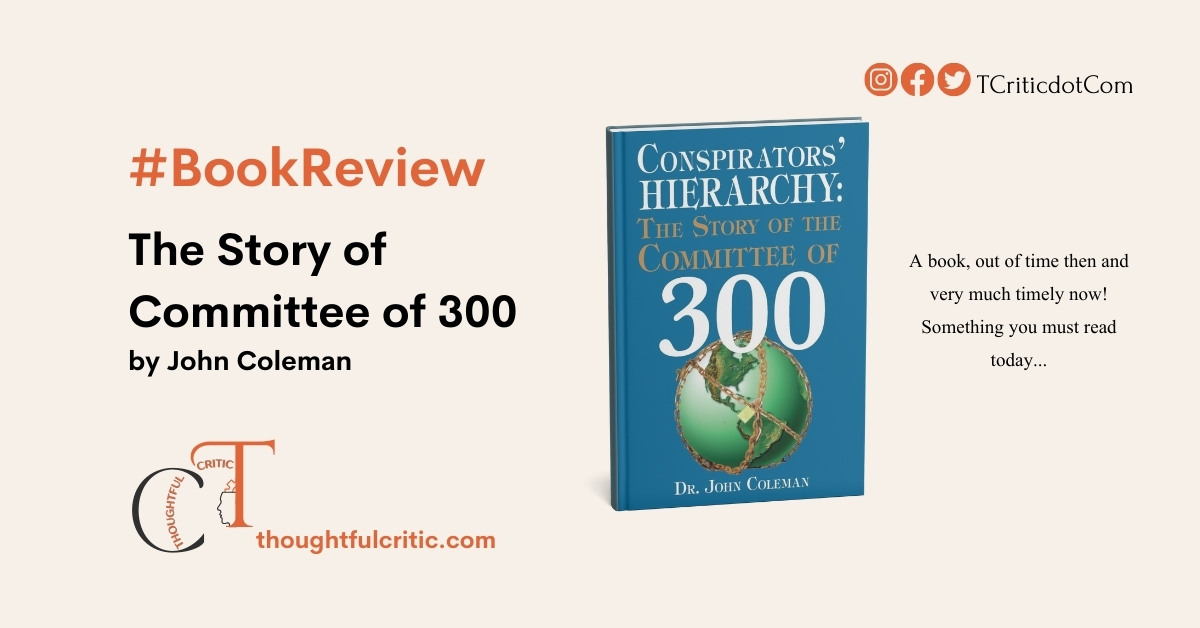Regarding conspiracy theory literature, John Coleman’s Conspirators’ Hierarchy: The Story of the Committee of 300 occupies a controversial yet enduring niche. First published in 1992, the book is a bold exposé and speculative manifesto, claiming that an elite secret society—the eponymous Committee of 300—controls global events to establish a totalitarian “One World Government.” Coleman’s work offers plenty to chew on for those who enjoy peeling back the layers of clandestine power and intrigue. But does it stand up to scrutiny? Not so much.
The Big Claim: A Shadowy Elite Runs the World
At its core, Coleman’s central thesis is that the Committee of 300—a clandestine cabal of influential figures—wields unprecedented power to orchestrate wars, manipulate economies, and shape public opinion. It’s a juicy narrative: humanity’s collective fate isn’t shaped by random chance or competing ideologies but by a group of shadowy puppet masters. According to Coleman, these elites pull the strings through a sprawling web of organisations, including think tanks, foundations, and secret societies like the Council on Foreign Relations and the Club of Rome.
The sheer audacity of this claim gives the book its allure. It’s provocative and taps into universal fears about losing control over one’s life. However, it’s also where the book begins to falter under the weight of its ambition. While Coleman throws out many names, institutions, and historical events, he rarely connects the dots with verifiable evidence. Reading Conspirators’ Hierarchy sometimes feels like attending a crime show where the detective presents the culprit in the first act without building a compelling case. You’re left wondering, “Where’s the evidence?”
What Coleman Gets Right: A Reflection of Our Discontent
Before diving into the book’s flaws, let’s give credit where credit is due. Coleman’s work endures not because of its accuracy but because it resonates with deep-seated anxieties. The early 1990s, when Coleman published his book, marked the rise of globalisation, growing economic disparities, and increasing distrust in institutions—trends that have only intensified in the digital age.
For many readers, the idea of an elite group controlling global events provides a simple, if unsettling, explanation for complex societal problems. Economic inequality? That’s the Committee tightening its grip. Wars and unrest? Carefully engineered distractions. The media’s one-sided narratives? That’s just propaganda to keep the masses complacent. In an era where trust in governments and institutions continues to erode, Coleman’s thesis feels disturbingly plausible—even if it remains largely unsupported.
The book also reflects a growing scepticism toward the cultural changes of the late 20th century. Coleman claims, for example, that the Committee uses rock music and drugs to destabilise society and destroy the family unit. While these claims sound outlandish today, they echo the moral panic of their time, when traditionalists viewed counterculture movements as existential threats.
The Writing: A Rollercoaster of Rhetoric
Coleman’s writing style is unapologetically assertive, brimming with certainty that borders on arrogance. There’s no room for ambiguity or alternative interpretations in his narrative. He presents his claims as undeniable truths, making sweeping generalisations about institutions and individuals. His tone sometimes veers into the inflammatory, with ad hominem attacks on those who dismiss his theories.
This bombastic style makes the book entertaining, albeit unintentionally at times. Coleman’s passion is palpable, and his vivid descriptions give the text a dramatic flair as if he’s narrating the ultimate espionage thriller. However, his approach may come off as more heat than light for readers expecting a balanced, scholarly exploration of global power structures.
A key problem with the writing is its lack of sourcing. Coleman often references secret documents or insider knowledge but rarely provides verifiable citations. When he does refer to real-world institutions or events, his interpretations are frequently speculative, if not outright conspiratorial. For example, his assertions about the Tavistock Institute as a mind-control hub seem plucked from the realm of dystopian fiction rather than grounded in documented fact.
Criticisms: Where the Book Falls Apart
- Conjecture Over Evidence
Coleman’s reliance on conjecture is the book’s Achilles’ heel. While it’s intriguing to imagine an elite cabal orchestrating world events, his failure to substantiate these claims undermines his credibility. He mentions institutions like the Trilateral Commission and Club of Rome as pawns of the Committee of 300 but offers no concrete evidence of their alleged coordination. The result? His argument feels more like an elaborate connect-the-dots game without the dots. - One-Dimensional Villains
Coleman portrays the Committee of 300 as an all-powerful entity that comes off as cartoonishly villainous. Coleman leaves little room for the chaotic, competing interests that define real-world geopolitics by framing them as omnipotent masterminds. The narrative is straight out of a James Bond film—entertaining but hard to take seriously. - Overreach
Coleman’s scope is staggering, covering everything from deindustrialisation to population control, yet this ambition becomes a liability. He oversimplifies complex historical and social dynamics by attributing virtually every significant societal change to the Committee. The result is a theory that feels less like an explanation and more like an all-encompassing blame game. - Outdated Arguments
Some of Coleman’s claims, particularly about rock music and drugs as tools of social engineering, feel dated and out of touch with contemporary realities. While these ideas might have resonated in the moral panics of the 1990s, they hold less sway in a world where societal changes are shaped by digital technology and decentralised movements.
What Coleman Might Have Got Right… Just Right
For all its bombast, Conspirators’ Hierarchy occasionally grazes the realm of plausibility, particularly in its discussion of population control, bio-weapons, and global manipulation. Here’s a closer look at some of Coleman’s claims that align with real-world anxieties:
1. “Useless Eaters” and Population Control
Coleman alleges that the Committee of 300 views much of humanity as “useless eaters,” a dehumanising term that implies a large segment of the population is expendable. This chilling perspective supposedly drives their efforts to reduce the global population through war, disease, and engineered scarcity. While this claim lacks concrete evidence, its grim resonance with ongoing debates about overpopulation and resource allocation ensures it doesn’t feel entirely outlandish.
2. The Global 2000 Report
Coleman references the Global 2000 Report, an actual document commissioned during Jimmy Carter’s presidency. While the report primarily focused on environmental sustainability and resource management, Coleman alleges it masked a sinister agenda to reduce the U.S. population by 100 million by 2050. He said this strategy included subtle but deliberate efforts to undermine industrial development, promote infertility, and exacerbate economic dependency.
While mainstream interpretations of the Global 2000 Report differ drastically, the idea of powerful entities exploiting such reports for covert purposes taps into real concerns about how global policies can disproportionately impact vulnerable populations.
3. Limited Wars and Third World Starvation
Coleman claims the Committee of 300 uses “limited wars” in advanced nations and orchestrates starvation and diseases in developing countries to achieve mass depopulation. His suggestion that Western powers exploit food scarcity as a political weapon has unsettling echoes in historical events. For instance, the weaponisation of food aid during Cold War conflicts and the systemic neglect of famine-stricken nations could partially validate Coleman’s assertions.
Furthermore, his prediction that warfare would shift from direct conflict to proxy wars and economic manipulation feels eerily prescient, given recent geopolitical trends, including the rise of hybrid warfare and resource-driven conflicts.
4. Chemical and Biological Warfare
One of the most gripping claims in the book is that the Committee of 300 funds research into chemical and biological warfare (CAB) through institutions like the Stanford Research Institute (SRI). Coleman alleges that these bio-weapons are part of a grand strategy to control populations, citing research into futurism and mass surveillance technologies.
While such claims sound alarmist, the growing prominence of bio-warfare concerns—particularly after the COVID-19 pandemic—gives them a new relevance. Discussions around gain-of-function research, bioterrorism, and the ethics of genetic engineering highlight the fine line between legitimate scientific progress and potential misuse. Coleman’s allegations, while unsubstantiated, tap into these fears, adding a chilling layer to his narrative.
5. Other Population Control Tactics
Coleman goes further, alleging that the Committee promotes:
- Forced abortions and sterilisations as tools to reduce population growth.
- Drug addiction to pacify and control the masses, effectively rendering people less capable of rebellion.
- Entertainment as a distraction, with Coleman claiming that modern media and music, mainly rock, are carefully curated tools to dismantle traditional family structures and foster compliance.
While such claims verge on the absurd, they intersect with legitimate critiques of cultural commodification and the social consequences of widespread drug addiction. The opioid crisis, for example, underscores how systemic failures in policy and oversight can devastate entire communities, lending partial credibility to Coleman’s broader concerns.
How It Compares to Other Conspiracy Literature
Conspiracy theory books often straddle the line between entertainment and scholarship. Compared to seminal works like Robert Anton Wilson’s The Illuminatus! Trilogy (satirical yet thought-provoking) or David Icke’s The Biggest Secret (equally speculative but more comprehensive), Coleman’s book feels heavy-handed. Unlike Wilson, who toys with ambiguity, or Icke, who dives deep into mythological parallels, Coleman’s narrative lacks nuance. His insistence on presenting his theories as fact leaves little room for readers to draw their conclusions.
Why It Still Matters (To Some)
Despite its flaws, Conspirators’ Hierarchy continues to find an audience, particularly among younger readers who discover it through the internet’s rabbit holes of conspiracy content. It appeals to those questioning the status quo, offering a tidy explanation for a chaotic and unjust world. The book’s longevity underscores the enduring appeal of conspiracy theories: they provide a sense of order and purpose, even if they’re more fantasy than reality.
Moreover, Coleman’s emphasis on institutional distrust resonates in today’s political polarisation and fake news climate. His critique of think tanks, media manipulation, and economic disparity aligns with contemporary concerns, albeit through a hyperbolic lens.
The Verdict: A Mixed Bag
Conspirators’ Hierarchy: The Story of the Committee of 300 is a bold, speculative, and occasionally paranoid product of its time. It will likely disappoint readers seeking a meticulously researched account of global power structures. The lack of evidence and overreliance on conjecture undermine its credibility, making it more of a cultural artefact than a reliable guide to world affairs.
However, the book has undeniable entertainment value for those who enjoy exploring the fringes of thought or are fascinated by the psychology of conspiracy theories. Its sweeping narrative and unrelenting confidence make it a page-turner, even if its claims require more salt than a lifetime of pretzels.
So, should you read it? If you’re looking for profound insights into global geopolitics, probably not. But if you’re in the mood for a wild ride through the labyrinth of conspiracy lore, strap in—because Coleman delivers a tale as ambitious as it is questionable. Just remember: scepticism isn’t a bad thing. After all, as Coleman himself might say, “Question everything”—even his theories.
You can get a copy of this book from Amazon India: click here to get a copy now.
Review by Rohit for Thoughtful Critic
The Conspirator's Hierarchy: The Committee of 300 by John Coleman Book Review
-
Critical Review
Summary
Interesting… if you read it to get high. It’s intriguing if you read it to think. Worrying if you read it and get serious about the state of affairs around you. The book is truly a must-read, especially today!




